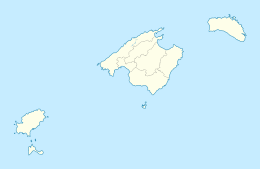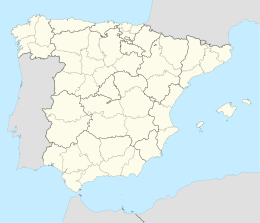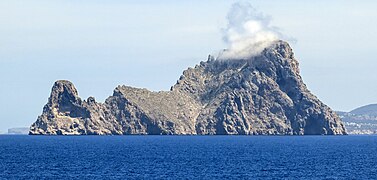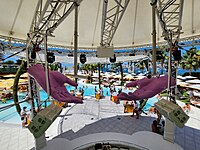Ibiza
This articleneeds additional citations forverification.(January 2021) |
Native name: Eivissa | |
|---|---|
 Flag of Ibiza | |
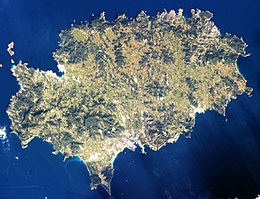 Satellite view (2013) | |
| Geography | |
| Location | Balearic Sea |
| Coordinates | 38°59′N1°26′E/ 38.98°N 1.43°E |
| Archipelago | Balearic Islands,Pityusic Islands |
| Area | 571.6 km2(220.7 sq mi) |
| Highest elevation | 475 m (1558 ft) |
| Highest point | Sa Talaiassa |
| Administration | |
Spain | |
| Autonomous Community | Balearic Islands |
| Province | Balearic Islands |
| Capital city | Ibiza Town |
| Largest settlement | Ibiza Town(pop. 51,872) |
| Government | Island Council of Ibiza |
| President | Vicente Marí (PP) |
| Demographics | |
| Population | 159,180 (1 January 2023) |
| Pop. density | 278.0/km2(720/sq mi) |
| Languages | Catalan,Spanish |
 | |
| Official name | Ibiza, Biodiversity and Culture |
| Type | Mixed |
| Criteria | ii, iii, iv, ix, x |
| Designated | 1999(23rdsession) |
| Reference no. | 417 |
| Region | Southern Europe |

Ibiza(Spanish:[iˈβiθa];Catalan:Eivissa,locally[əjˈvisə];see below) is a Spanish island in theMediterranean Seaoff the eastern coast of theIberian Peninsula.It is 150 kilometres (93 miles) from the city ofValencia.It is the third largest of theBalearic Islandsin area, but the second-largest by population. Its largest settlements areIbiza Town(Catalan:Vila d'Eivissa,or simplyVila),Santa Eulària des Riu,andSant Antoni de Portmany.Its highest point, calledSa Talaiassa(or Sa Talaia), is 475 metres (1,558 feet)above sea level.
Ibiza is well known for itsnightlifeandelectronic dance musicclub scene in the summer, which attract large numbers of tourists. The island's government and the Spanish Tourist Office have worked toward promoting more family-oriented tourism.[1][2]
Ibiza is a UNESCO World Heritage Site.[3]Ibiza and the nearby island ofFormenterato its south are called the Pine Islands, or "Pityuses".
Names
[edit]InBritish English,the name is usually pronounced in an approximation of thePeninsular Spanishvariant (/ɪˈbiːθə/ib-EE-thə).[4]InAmerican Englishthe pronunciation is closer to theLatin American Spanishvariant (/ɪˈbiːzə/ib-EE-zə,[5]/iːˈbiːsə/ee-BEE-sə,[6][7][8]and so forth) and never pronounces the first syllable as a homophone of "eye".
Phoenician colonists called the islandI Boss imorIboshim(cf. Hebrew אִי־בּוֹשֵׂם, "Fragrance Island" ), likely due the abundance of aromatic plants on the island. Other speculation is (Phoenician:𐤀𐤉𐤁𐤔𐤌,ʾYBŠM,[9]"Dedicated toBes").[10][11]It was later known to Romans asEbusus.
Its name inSpanishisIbiza(pronounced[iˈβisa]in Latin America or[iˈβiθa]in Spain). TheCatalanname isEivissa(locally[əjˈvisə]).
TheGreekscalled the two islands of Ibiza andFormenterathePityoûssai(Πιτυοῦσσαι,probably meaning "Pine-Covered Islands" ).[12]The Catalan namePitiüsesand the Spanish namePitiusasretain this Greek root.
In the 18th and 19th centuries the island was known to the British and especially to theRoyal NavyasIvica,possibly from an older Spanish orthography with⟨ç⟩.[13]
History
[edit]
In 654 BC,Phoeniciansettlersfounded a port on Ibiza.With the decline of Phoenicia after theAssyrianinvasions, Ibiza came under the control ofCarthage,also a former Phoenician colony. The island produced dye, salt, fish sauce (garum) and wool.
A shrine with offerings to the goddessTanitwas established in the cave at Es Cuieram, and the rest of the Balearic Islands entered Eivissa's commercial orbit after 400 BC. Ibiza was a major trading post along the Mediterranean routes. Ibiza began establishing its own trading stations along the nearby Balearic island ofMajorca,such asNa Guardis,and "Na Galera" where numerous Balearic mercenaries hired on, no doubt asslingers,[a]to fight for Carthage.
During theSecond Punic War,the island was assaulted by the two Scipio brothers (PubliusandGnaeus) in 217 BC but remained loyal to Carthage. With the Carthaginian military failing on theIberianmainland, Ibiza was last used, 205 B.C, by the fleeing Carthaginian general Mago to gather supplies and men before sailing toMenorcaand then toLiguria.Ibiza negotiated a favorable treaty (Foedus) with theRomans,which spared Ibiza from further destruction and allowed it to continue its Carthaginian-Punic institutions, traditions and even coinage well into the Empire days, when it became an official Roman municipality.
After the fall of the Western Roman Empire and a brief period of firstVandaland thenByzantinerule, the island was conquered by theMuslimsin 902, the few remaining locals converted to Islam and Berber settlers came in. Under Islamic rule, Ibiza (Yabisah) came in close contact with the city ofDénia—the closest port in the nearby Iberian peninsula, located in theValencian Community—and the two areas were administered jointly by theTaifa of Déniafor some time (11th century).

Ibiza, together with the islands ofFormenteraandMenorca,were invaded by theNorwegianKingSigurd I of Norwayin the spring of 1110 onhis crusadetoJerusalem.The king had previously conquered the cities ofSintra,LisbonandAlcácer do Saland given them over toChristianrulers, in an effort to weaken theMuslimgrip on the Iberian peninsula. King Sigurd continued toSicilywhere he visited KingRoger II of Sicily.[15]
The island wasconqueredfor theCrown of Aragonin 1235.[16]The local Muslim population was deported, as was the case with neighboring Majorca and elsewhere, and Christians arrived from Girona. The island maintained its own self-government in several forms until 1715, when KingPhilip V of Spainabolished the local government's autonomy. The arrival of democracy in the late 1970s led to theStatute of Autonomy of the Balearic Islands.Today, the island is part of the Balearic Autonomous Community, along withMajorca,MenorcaandFormentera.
World Heritage Site
[edit]Though primarily known for its party scene, large portions of the island are registered as UNESCOWorld Heritage Sites.[17]
A notable example includes the Renaissance walls of the old town of Ibiza City, which were awarded UNESCO World Heritage Status in 1999. They are one of the world's few Renaissance walls that were not demolished, and part of the medieval wall is still visible. There are some Ibizan cultural sites, such as the remains of the first Phoenician settlement atSa Caleta.Other sites are still under threat from the developers, such asSes Feixes Wetlands,but this site has now been recognised as a threatened environment, and it is expected that steps will be taken to preserve this wetland. The oceanic plantPosidonia oceanicais also part of UNESCO's World Heritage.
Geography
[edit]
-
PenjatsIsland is the southernmost islet of Ibiza
Ibiza is a rock island covering an area of 572.56 square kilometres (221.07 sq mi), almost one-sixth the size ofMajorca,but over five times larger thanMykonosin theGreek Isles,or 10 times larger thanManhattanin New York City.
Ibiza is the larger of a group of the western Balearic archipelago called thePityusic Islands(Pitiusas) or "Pine Islands" composed of itself andFormentera.The Balearic island chain includes over 50 islands, many of which are uninhabited. The highest point of the island isSa Talaiassa,also known as Sa Talaia or Sa Talaia de Sant Josep at 475 metres (1,558 ft).
Administration
[edit]Ibiza is administratively part of theautonomous communityof theBalearic Islands,whose capital isPalma,on the island ofMajorca.Ibiza comprises five ofthe region's 67 municipalities:
| Map | Municipality | Area in square km |
Population 1 Nov 2011 |
Population 1 Jan 2021 |
Population 1 Jan 2023[18] |
|---|---|---|---|---|---|
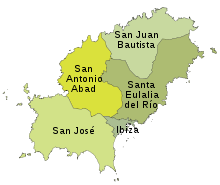
|
Sant Josep de sa Talaia(Spanish:San José) | 159.4 | 24,079 | 29,015 | 30,340 |
| Sant Antoni de Portmany(San Antonio Abad) | 126.8 | 21,915 | 27,582 | 28,551 | |
| Sant Joan de Labritja(San Juan Bautista) | 121.7 | 5,351 | 6,610 | 6,809 | |
| Santa Eulària des Riu(Santa Eulalia del Río) | 153.6 | 33,699 | 40,413 | 41,608 | |
| Vila d'Eivissa(Ibiza) | 11.1 | 48,550 | 50,566 | 51,872 | |
| Totals | 572.6 | 133,594 | 154,186 | 159,180 |
At the2001 censusthese municipalities had a total population of 88,076 inhabitants, which had risen to an officially estimated total of 159,180 at the start of 2023,[19]and have a land area of 572.56 km2(221.07 sq mi).
The island's self-government institution is the Ibiza Island Council (Consell Insular d'Eivissa). Prior to its split in 2007,Formenterawas part of the council.[20]
Insular government
[edit]Elections are held every four years concurrently withlocal elections.From 1983 to 2007, councilors were indirectly elected from the results of the election toParliament of the Balearic Islandsfor the constituencies ofIbizaandFormentera(then forming a single Island council, with Ibiza sending 12 councilors and Formentera a single one). Since 2007, however, separate direct elections are held to elect the Island Council of Ibiza, which has kept 13 as the number of seats (despite sending 12 to the Balearic Parliament).
Results of the elections to the former Island Council of Ibiza and Formentera
[edit]Island Councilors of the Island Council of Ibiza and Formentera between 1978 and 2007 | ||||||
|---|---|---|---|---|---|---|
| Election | Distribution | President | ||||
| 1979[21] |
|
Cosme Vidal Juan (ICIF–CD,CP) | ||||
| 1983 |
|
|||||
| 1987 |
|
Antoni Marí (PP) | ||||
| 1991 |
| |||||
| 1995 |
| |||||
| 1999 |
|
Pilar Costa (Pacte Progressista) | ||||
| 2003 |
|
Pere Palau (PP) | ||||
| Split into the Island Councils of Ibiza andFormenterarespectively, with the 2007 Amendment of theStatue of Autonomycoming into effect. | ||||||
Results of the elections to the Island Council of Ibiza
[edit]Island Councilors of the Island Council of Ibiza since 2007 | |||||||
|---|---|---|---|---|---|---|---|
| Election | Distribution | President | |||||
| 2007 |
|
Xico Tarrés (PSOE–ExC) | |||||
| 2011 |
|
Vicent Serra (PP) | |||||
| 2015 |
|
Vicente Torres (PSIB–PSOE) | |||||
| 2019 |
|
Vicente Marí (PP) | |||||
| 2023 |
| ||||||
Climate
[edit]Ibiza has ahot semi-arid climate(Köppen:BSh), bordering on ahot-summer Mediterranean climate(Csa). The average annual temperature of Ibiza is 18.3 °C (65 °F), being warm and mild throughout the whole year. Ibiza lies at the same latitude asAtlantic City,yet it is much warmer for its location in theMediterranean Basin.The climate of Ibiza is typically warm, sunny and dry, with low variation between highs and lows. The sunshine hours of Ibiza are 2700-2800 per year, while the yearly rain amount goes from 400 to 450 millimetres (16 to 18 in). The average high temperature is 22.2 °C (72 °F), while the average low is 14.3 °C (58 °F). Winters are slightly rainy and mild, from November to April normally the whole island turns green for the seasonal rains. Summers are hot and fairly humid, but with very little rainfall. The few rainy days are often accompanied by thunderstorms. During the coldest month, January, the average high temperature is 15.7 °C (60 °F), while the average low is 8.1 °C (47 °F). In the warmest month, August, the average high temperature is 30.3 °C (87 °F), while the low is 22.2 °C (72 °F). Extreme temperatures are rare for the influence of the sea. The average temperature of the sea in Ibiza is 19.7 °C (67 °F)[22]and beach weather usually lasts 7 months, from May to November. The highest temperature ever recorded on Ibiza Airport is 40.7 °C (105 °F) on 13 August 2022.
| Climate data for Eivissa Airport 6 metres (20 feet) (1981–2010) | |||||||||||||
|---|---|---|---|---|---|---|---|---|---|---|---|---|---|
| Month | Jan | Feb | Mar | Apr | May | Jun | Jul | Aug | Sep | Oct | Nov | Dec | Year |
| Record high °C (°F) | 24.7 (76.5) |
23.5 (74.3) |
26.5 (79.7) |
27.8 (82.0) |
31.0 (87.8) |
36.5 (97.7) |
36.6 (97.9) |
36.6 (97.9) |
38.4 (101.1) |
32.0 (89.6) |
28.4 (83.1) |
23.8 (74.8) |
38.4 (101.1) |
| Mean daily maximum °C (°F) | 15.7 (60.3) |
15.9 (60.6) |
17.7 (63.9) |
19.7 (67.5) |
22.7 (72.9) |
26.8 (80.2) |
29.7 (85.5) |
30.3 (86.5) |
27.7 (81.9) |
24.0 (75.2) |
19.6 (67.3) |
16.7 (62.1) |
22.2 (72.0) |
| Daily mean °C (°F) | 11.9 (53.4) |
12.1 (53.8) |
13.7 (56.7) |
15.6 (60.1) |
18.6 (65.5) |
22.6 (72.7) |
25.6 (78.1) |
26.3 (79.3) |
23.8 (74.8) |
20.2 (68.4) |
15.9 (60.6) |
13.1 (55.6) |
18.3 (64.9) |
| Mean daily minimum °C (°F) | 8.1 (46.6) |
8.3 (46.9) |
9.6 (49.3) |
11.4 (52.5) |
14.6 (58.3) |
18.4 (65.1) |
21.4 (70.5) |
22.2 (72.0) |
19.9 (67.8) |
16.5 (61.7) |
12.3 (54.1) |
9.5 (49.1) |
14.3 (57.7) |
| Record low °C (°F) | −1.2 (29.8) |
0.2 (32.4) |
1.0 (33.8) |
3.4 (38.1) |
7.6 (45.7) |
10.0 (50.0) |
15.9 (60.6) |
16.5 (61.7) |
12.1 (53.8) |
8.5 (47.3) |
2.4 (36.3) |
1.1 (34.0) |
−1.2 (29.8) |
| Averageprecipitationmm (inches) | 37 (1.5) |
36 (1.4) |
27 (1.1) |
31 (1.2) |
27 (1.1) |
11 (0.4) |
5 (0.2) |
18 (0.7) |
57 (2.2) |
58 (2.3) |
53 (2.1) |
52 (2.0) |
413 (16.3) |
| Average precipitation days(≥ 1 mm) | 5 | 5 | 3 | 4 | 3 | 1 | 1 | 2 | 4 | 6 | 6 | 5 | 45 |
| Average snowy days | 0.1 | 0.0 | 0.0 | 0.0 | 0.0 | 0.0 | 0.0 | 0.0 | 0.0 | 0.0 | 0.0 | 0.0 | 0.1 |
| Mean monthlysunshine hours | 162 | 166 | 211 | 246 | 272 | 299 | 334 | 305 | 236 | 205 | 157 | 151 | 2,744 |
| Percentpossible sunshine | 52 | 54 | 57 | 63 | 63 | 67 | 72 | 70 | 66 | 60 | 52 | 54 | 61 |
| Source 1:Agencia Estatal de Meteorología[23] | |||||||||||||
| Source 2:Agencia Estatal de Meteorología,[24] | |||||||||||||
| Climate data for Ibiza | |||||||||||||
|---|---|---|---|---|---|---|---|---|---|---|---|---|---|
| Month | Jan | Feb | Mar | Apr | May | Jun | Jul | Aug | Sep | Oct | Nov | Dec | Year |
| Average sea temperature °C (°F) | 14.7 (58.5) |
14.3 (57.7) |
14.5 (58.0) |
16.3 (61.4) |
19.1 (66.3) |
22.5 (72.6) |
25.1 (77.1) |
26.2 (79.1) |
25.2 (77.4) |
22.7 (72.9) |
19.6 (67.3) |
16.6 (61.8) |
19.7 (67.5) |
| Mean daily daylight hours | 10.0 | 11.0 | 12.0 | 13.0 | 14.0 | 15.0 | 15.0 | 14.0 | 12.0 | 11.0 | 10.0 | 9.0 | 12.2 |
| Averageultraviolet index | 2 | 3 | 5 | 6 | 8 | 9 | 9 | 8 | 6 | 4 | 3 | 2 | 5.4 |
| Source #1: seatemperature.org[25] | |||||||||||||
| Source #2: Weather Atlas[26] | |||||||||||||
People
[edit]Demographically, Ibiza displays a very peculiar configuration, as census agencies diverge on exact figures. According to the 2001 national census, Ibiza had 88,076 inhabitants (against 76,000 in 1991, 64,000 in 1981, 45,000 in 1971, and 38,000 in 1961). However, by the 2011 national census, this had grown to 133,594, and at the Census of 2021 had reached 154,186. This rapid growth stems from the amnesty which incorporated a number of unregistered foreign migrants. In terms of origin, about 55 percent of island residents were born in Ibiza; 35 percent are domestic migrants from mainland Spain (mostly working-class families from Andalusia, and the remainder from Catalonia, Valencia and Castile); and the remaining 10 to 15 per cent are foreign, dual and multi-national citizens of the EU and abroad (Govern de les Illes Balears – IBAE 1996). In decreasing order, the most commonly visiting foreigners areGerman,British,Latin American,French,ItalianandDutch.
The Spanish composer and music theoristMiguel Roig-Francolíwas born in Ibiza,[27]as was the politician and Spain's former Minister of Foreign Affairs,Abel Matutes.[28]Notable former residents of Ibiza include: Spandau Ballet'sSteve Norman,English punk musicianSid Vicious,[29]comic actorTerry-Thomas,[30]Hungarian master forgerElmyr de Hory,[31]American authorsCormac McCarthyandClifford Irving.[32]
Language
[edit]Eivissencis the native dialect ofCatalanthat is spoken on Ibiza and nearbyFormentera.Catalan shares co-official status withSpanish.Additionally, because of the influence of tourism andimmigrantsliving in or maintaining residences on the island, other languages, such as English, French, German and Italian, are widely spoken.[33]
Tourism
[edit]Nightlife
[edit]Ibiza is considered to be a popular tourist destination, especially due to its well-known and at times riotousnightclub-based nightlife centred on two areas:Ibiza Town,the island's capital on the southern shore andSant Antonito the west. Ibiza has garnered the reputation as the "Party Capital of the world".[34][35]
Nightlifein Ibiza has undergone several changes since the island's opening to international tourism in the late 1950s. Origins of today's club culture may be traced back tohippiegatherings held during the 1960s and 1970s.[citation needed]During these, people of various nationalities sharing the hippie ethos would regroup, talk, play music and occasionally takerecreational drugs.These would most often happen on beaches during the day, with nude bathing a common sight, and in rented country estates in the evenings or at nights. Apart from this confidential scene, which nevertheless attracted many foreigners to the island, local venues during the 1960s consisted mostly of bars, which would be the meeting points for Ibicencos, ex-pats, seafarers and tourists. The Estrella bar on the port and La Tierra in the old city of Eivissa were favourites.[36]
During the 1970s, a decade that saw the emergence of the contemporary nightclub, several venues opened and made a lasting impact on Ibiza's nightlife.[citation needed]Three of these original clubs are still in operation today:Pacha,Amnesiaand Es Paradís.[clarification needed]These four clubs mainly defined nightlife on the White Island, which has evolved and developed from several distinctive elements: open-air parties (Es Paradis, Privilege, Amnesia), held in isolated places, eventually old fincas (Pacha, Amnesia), that mixed in nudity and costume party (Es Paradis, Privilege, Pacha) and enabled people from various backgrounds to blend (all). The hippie ethos served as a common factor that infused all these venues and catalyzed the experience of a certain kind of freedom, accentuated by the holiday nature of most of the stays on the White Island.[citation needed]
During the 1980s, the music played in these clubs gained in reputation and became known asBalearic beat,a precursor of the Britishacid housescene. Asraveparties blossomed all over Europe, a DJ-driven club culture took hold of Ibizenca nightlife. It was at that time thatSpaceopened, thanks to Pepe Rosello, which found a niche in the after-hour parties.[37]The club would close at 18:00 and open again at 07:00, when all the other clubs were still closed, enabling party-goers to flock from the other clubs to Space and continue dancing in broad daylight.[37]
At the end of the 1990s, the after-hour parties took firm root on the island. In 1999, theCircolocoparties made their debut atDC10,with some of the original elements of Ibiza nightlife at the forefront.[citation needed]
In recent years, during the summer, top producers andDJsin dance music come to the island and play at the various clubs, in between touring to other international destinations. Some of the most famous DJs run their own weekly nights around the island. Many of these DJs use Ibiza as an outlet for presenting new songs within thehouse,tranceandtechnogenres ofelectronic dancemusic. The island has achieved fame as a cultural centre forhouseandtrancein particular, with its name often being used as a partialmetonymfor the particular flavour of electronic music originating there, much likeGoain India.[citation needed]
Since 2005, the live music eventIbiza Rockshas changed perceptions of the Ibiza party landscape.[38]Bands such asArctic Monkeys,Kasabian,The Prodigyand theKaiser Chiefshave played in the courtyard of the Ibiza Rocks Hotel.[39]
The season now traditionally begins at the end of April, where Opening Parties take place at Ibiza's clubs over the course of a three-week period. Opening Parties normally coincide with the culmination of theInternational Music Summit,a three-day conference promoting the electronic music industry, featuring speakers, masterclasses and performances, and co-hosted by Pete Tong and Jaguar. IMS has taken place on the island annually since 2007 and holds its closing party at the top of Dalt Vila.[40][41]The first clubs that host opening parties are normally Ushuaïa, Hï, Amnesia, and Pacha.[42]The first parties take place at the end of April, starting with the Hï and Ushuaïa Opening Parties, and the last parties occur around mid-October, usually being the Amnesia and Pacha Closing Parties.[43]
Other
[edit]The island's government is in the process of making policy changes[when?]to encourage a more family-friendly and quieter tourism scene. These include rules such as the closing of all nightclubs by 06:00 at the latest and requiring all new hotels to be 5-star.[44]The administration wants to attract a more international mixture of tourists.[45][clarification needed][needs update]
The island's tourism is not always characterized by its nightlife. Visitors can take a hot-air balloon ride, surf, visit the Cave Can Mark, or go to Cap Blanc's Aquarium.[46]
Development
[edit]Since the early days of mass tourism on the island, there have been a large number of development projects ranging from successful ventures, such as the super clubs atSpaceandPrivilege,to failed development projects, such asJosep Lluís Sert's abandoned hotel complex at Cala D'en Serra,[47]the half-completed and now demolished "Idea" nightclub inSant Antoni,[48]

and the ruins of a huge restaurant/nightclub in the hills nearSant Josepcalled "Festival Club" that only operated for three summer seasons in the early 1970s.[49]The transient nature of club-oriented tourism is most obvious in these ruins scattered all over the island. Local artist Irene de Andrès has tackled the difficult issue of the impact of mass tourism on the island local landscapes, both natural and cultural, in an ongoing project called "Donde nada ocurre" (Where nothing happens).[50]In 2013, Ibiza property prices generally remained above market value, and many of the development projects on the island have now been completed or continue, as well as some new projects announced at the end of 2012. Since 2009, Ibiza has received an increase in the number of tourists every year, with nearly 6 million people travelling throughIbiza Airportin 2012. The summer season has become concentrated between June and September, focusing on the "clubbing calendar"[51]which is currently booming. In recent years, the luxury market has dramatically improved, with new restaurants, clubs, and improvements to the marina in Ibiza Town.[52]
Ibiza's increased popularity has led to problems with potable water shortages and overrun infrastructure.[53]This has led to the imposition of a "Sustainable Tourism Tax" which went into effect on 1 July 2016.[54]Minister of Tourism Vincente Torres stated in an interview in 2016 that the government has instituted a moratorium on building in certain areas. He said that with almost 100,000 legal tourist beds and about 132,000 inhabitants on the island's 572 square kilometres (221 sq mi) not much more tourism can be supported.[54]
Transport
[edit]
Ibiza has its ownairport,which has many international flights during the summer tourist season, especially from the European Union and the United Kingdom.
There are alsoferriesfrom the harbour of Sant Antoni and Ibiza Town toBarcelona,Majorca,Dénia,andValencia.There are also ferries to Formentera leaving Sant Antoni Harbour (normally every Wednesday), and daily from Ibiza Town, Santa Eulària, and Figueretes–Platja d'en Bossa.[55]
Several public buses also travel between Sant Antoni and Ibiza Town, every 15 minutes in summer and every half-hour in winter. In addition, there are buses from Sant Antoni to Cala Bassa, Cala Conta and Cala Tarida, and to the airport. From Ibiza there are buses to the Platja d'en Bossa, Ses Salines, the airport and Santa Eulària.[56]The late night bus line that stops at the various clubs is locally known as the Disco Bus.[57]
In popular culture
[edit]A number of novels and other books have been written using Ibiza as the setting, including "The Canticle of Ibiza" by Justin Kurian, "The White Island" by Stephen Armstrong,Joshua Then and NowbyMordecai Richler,Soma BluesbyRobert Sheckley,[58]Vacation in IbizabyLawrence Schimel,[59]A Short Life on a Sunny 'sIsle: An Alphonse Dantan MysterybyHannah Blank,[60]They Are Ruining Ibizaby A. C. Greene,[61]andThe Python ProjectbyVictor Canning.[62]Books includingIbiza Bohemia,[63]which was published byAssouline,have explored the island itself with both photography and text, while other such asMemes Eivissencshave registered the traditions of their residents and their history in social media.
The third track onPrefab Sprout's 1990 albumJordan: The Comebackis 'Machine Gun Ibiza'.[64]It is also mentioned inDavid Bowie's 1971 track 'Life on Mars?', "See the mice in their million hordes, from Ibiza to theNorfolk Broads."[65]
InMonty Python's Flying Circus,the opening sketch of Episode 33 features the pilot Biggles. His secretary teasingly calls him "Señor Biggles", and Biggles protests, saying, "I've never even been to Spain." The secretary responds, "You went to Ibiza last year." Biggles counters, "That's still not grounds for calling me señor, or Don Beeg-les for that matter."[66]
Wham's1983 hit single"Club Tropicana"music video was filmed inIbiza.It was the first timeGeorge Michael&Andrew Ridgeleywould leave the UK.
Vengaboys' 1999 single "We're Going to Ibiza"reached number one on the singles chart in United Kingdom and the Netherlands. The song saw a resurgence in Austria in 2019 due to theIbiza affair.
The island is shown as the home of notorious art forger, Elmyr de Hory, in the 1973 docudramaF for FakebyOrson Welles.
The fourth track off ofThe Prodigy’ssixth studio albumThe Day Is My Enemyis titled Ibiza. The song has fast rapping and electronic beats. The rapping is performed by the band’s frontmanKeith Flint(died 2019).
In popular music, American singer-songwriterMike Posnerreleased "I Took a Pill in Ibiza"(alternatively known as" In Ibiza ", or its clean title" I Took a Plane to Ibiza ") in April 2015, as single on hisVevoaccount and in the exclusiveThe TruthEP; it was later released onAt Night, Alonein May 2016. Originally an acoustic guitar-basedfolk popsong, it was remixed by the Norwegian duoSeeBas atropical housedance popsong, and released digitally as a single in the United States on 24 July 2015. "I Took a Pill in Ibiza" peaked at #4 on theBillboardHot 100in the U.S.,[67]and reached #1 on seventeen other charts. Tourism officials in Ibiza were reportedly "annoyed" by the song's apparent reinforcement of drug culture associated with Ibiza in the past, and Tourism Director Vicent Ferrer subsequently invited Posner to witness the island's culture and how it contrasts with the party "typecast".[68]
Gallery
[edit]-
Las Puertas de Can Soleil
-
Cala d'en Serra
-
Platges de Comte
-
Cova de Can Marçà
-
Time and Space sculpture
-
Pukka Up boat party
-
Ushuaïa Ibiza
-
Ibiza Rocks day club
Explanatory notes
[edit]References
[edit]Citations
[edit]- ^Ibiza renews its party spiritArchived3 June 2023 at theWayback Machine,Luke Bainbridge, 27 June 2010 (The Guardian)
- ^Inside the police crackdown on Ibizas endless party cultureArchived16 September 2020 at theWayback MachineMichelle Lhooqe, 13 November 2015 (Vice TV website)
- ^"Ibiza, Biodiversity and Culture".UNESCO.United Nations.Archivedfrom the original on 25 October 2023.Retrieved14 February2018.
- ^"Ibiza".Oxford English Dictionary(Online ed.).Oxford University Press.(Subscription orparticipating institution membershiprequired.)
- ^Random House dictionary
- ^American Heritage Dictionary
- ^Jones, Daniel;Peter Roach; et al. (2003).English Pronouncing Dictionary(16th ed.). Cambridge: Cambridge University Press.
- ^Wells, John C.(2000).Longman Pronunuciation Dictionary(2nd ed.). Harlow: Pearson Education Limited.
- ^Head & al. (1911),p. 3.
- ^"Ibiza Literature, Literature in Ibiza".Liveibiza. Archived fromthe originalon 4 July 2019.Retrieved26 March2013.
- ^Kuhbier, Heinrich; Alcover, Josep Antoni; Guerau d'Arellano Tur, Cristòfol, eds. (1984).Biogeography and Ecology of the Pityusic Islands.Monographiae Biologicae, Volume 52. The Hague, The Netherlands: Dr. W. Junk (Kluwer). p. 1.ISBN978-90-6193-105-8.
- ^Antoni Ordinas Garau, Jaume Binimelis Sebastián:Singularidades toponímicas de las islas PitiusasArchived1 October 2023 at theWayback Machine(In Spanish)
- ^"Ivica".Encyclopaedia Metropolitana, Or, Universal Dictionary of Knowledge.Vol. 21. London. 1845. p.167.
- ^Strab. xiv. p. 654; Plin. l. c.Sil. Ital.iii. 364, 365.
- ^Jakobsson, Ármann (13 September 2013)."Image is Everything: The Morkinskinna Account of King Sigurðr of Norway's Journey to the Holy Land".Parergon.30(1): 121–140.doi:10.1353/pgn.2013.0016.ISSN1832-8334.S2CID143449956.Archivedfrom the original on 25 July 2021.Retrieved3 January2019.
- ^Abulafia, David.The rise of Aragon-Catalonia.na, 1999. pp. 5
- ^Centre, UNESCO World Heritage."Ibiza, Biodiversity and Culture".Archivedfrom the original on 6 December 2018.Retrieved26 December2019.
- ^Instituto Nacional de Estadística, Madrid.
- ^Instituto Nacional de Estadística, Madrid, 2024.
- ^Vila, Ester (29 June 2018)."39 años de democracia con el Consell d'Eivissa".Diario de Ibiza.Archivedfrom the original on 20 April 2021.Retrieved20 April2021.
- ^Rotger Lebrón, Martín (2021)."LES ELECCIONS PREAUTONÒMIQUES A LES ILLES BALEARS DE 1979"[1979 PREAUTONOMOUS ELECTIONS IN THE BALEARIC ISLANDS](PDF).Mayurqa(in Catalan).3:107–121.doi:10.22307/2386.7124.2021.01.008.Archived(PDF)from the original on 25 March 2024.Retrieved11 February2024.
- ^Ltd, Copyright Global Sea Temperatures - A-Connect."Ibiza Water Temperature - Spain - Sea Temperatures".World Sea Temperatures.Archivedfrom the original on 1 December 2017.Retrieved24 November2017.
- ^"Valores climatológicos normales. Ibiza, Aeropuerto".March 2016.Archivedfrom the original on 5 April 2016.Retrieved24 March2016.
- ^"Valores extremos. Ibiza, Aeropuerto".March 2016.Archivedfrom the original on 25 October 2018.Retrieved24 March2016.
- ^"Ibiza Sea Temperature".seatemperature.org.Archivedfrom the original on 22 October 2016.Retrieved15 March2017.
- ^"Ibiza, Spain - Climate data".Weather Atlas.Archivedfrom the original on 16 March 2017.Retrieved15 March2017.
- ^Enciclopèdia d'Eivissa i Formentera."Roig-Francoli Costa, Miguel Angel"Archived28 April 2018 at theWayback Machine
- ^Who's Who atNATO."Abel Matutes"Archived26 September 2011 at theWayback Machine
- ^"Sid Vicious - Life History Part 1".punk77.co.uk.Archivedfrom the original on 23 June 2010.Retrieved29 June2011.
- ^Bounder! The Biography of Terry-ThomasArchived25 October 2023 at theWayback Machineby Graham McCann, serialised inThe Times
- ^Clark, Thomas G. (18 May 2011)."Sant Agustí".Archivedfrom the original on 18 August 2011.Retrieved29 June2011.
- ^"Ibiza Literature, Literature in Ibiza".Archived fromthe originalon 9 September 2012.Retrieved29 June2011.
- ^"Le guide touristique IBIZA du Petit Futé: Population et langues (français)".13 August 2017.Archivedfrom the original on 13 August 2017.Retrieved13 August2017.
- ^Levy, Dantelle (15 June 2022)."Crash Course: The History Of Ibiza, The Party Capital Of The World".Edm Maniac.Archivedfrom the original on 9 October 2022.Retrieved9 October2022.
- ^Levine, Maya Kachroo (26 May 2021)."How Ibiza Became the Most Sought-after Party Capital in the World".Travel and Leisure.Archivedfrom the original on 9 October 2022.Retrieved9 October2022.
- ^"Bares y cafés de la Marina".Diario de Ibiza.23 December 2016.Archivedfrom the original on 25 October 2023.Retrieved24 December2016.
- ^ab"Space Ibiza's Odyssey History".Space Ibiza.Archivedfrom the original on 11 November 2023.Retrieved5 February2024.
- ^Cooke, Emma."How Ibiza's party really started".bbc.Archivedfrom the original on 27 February 2021.Retrieved25 March2021.
- ^"About Ibiza Rocks".Archivedfrom the original on 12 January 2024.Retrieved5 February2024.
- ^Lamond, Ana (2 April 2024)."IMS Ibiza 2024 Celebrates Its Fifteenth Edition With A Community-Focussed Programme | News".Clash Magazine Music News, Reviews & Interviews.Archivedfrom the original on 16 April 2024.Retrieved17 April2024.
- ^Bain, Katie (3 May 2022)."Inside Track: Dance Music Looks to Find Its Footing — and Some Respect — at IMS Ibiza".Billboard.Archivedfrom the original on 9 April 2024.Retrieved17 April2024.
- ^"Ibiza Opening Parties".Tickets Ibiza.2024.Archivedfrom the original on 14 October 2022.Retrieved5 February2024.
- ^"Ibiza 2023 closing party guide".Ibiza Spotlight.2023.Archivedfrom the original on 29 November 2023.Retrieved5 February2024.
- ^Robbins, Tom (18 November 2007)."Is the party over in Ibiza?".The Guardian.London.Archivedfrom the original on 5 March 2017.Retrieved4 May2010.
- ^"Is Ibiza changing??".Bbs.clubplanet. Archived fromthe originalon 5 November 2013.Retrieved26 March2013.
- ^"Las Islas Baleares, un destino familiar ideal".Vipealo.4 December 2020.Archivedfrom the original on 26 January 2021.Retrieved4 December2020.
- ^Clark, Thomas G. (7 July 2011)."Josep Lluís Sert's abandoned hotel at Cala D'en Serra".Archivedfrom the original on 18 August 2011.Retrieved29 June2011.
- ^Clark, Thomas G. (29 May 2011)."An abandoned Idea".Archivedfrom the original on 22 March 2012.Retrieved29 June2011.
- ^"Ibiza Party".TravelnTourism. Archived fromthe originalon 25 June 2016.Retrieved18 June2016.
- ^"Irene de Andrès website".24 December 2016.Archivedfrom the original on 21 October 2016.Retrieved24 December2016.
- ^"Vakantie Ibiza 2017" De beste tips voor op vakantie! ".Europa Vakanties(in Dutch). 4 January 2015.Archivedfrom the original on 16 September 2018.Retrieved16 September2018.
- ^"Ibiza – a hedonist's paradise whatever your poison".Ibiza Traveller. Archived fromthe originalon 14 July 2014.Retrieved6 July2014.
- ^Berry, Katherine (2015)."Ibiza's Water Shortage".Ibicasa Magazine.Archivedfrom the original on 18 June 2021.Retrieved2 November2023.
- ^abShortlidge, Chadler (17 July 2016)."Ibiza" Cannot Support Much More Increase in Tourism "Says Govt".Pulse.Archived fromthe originalon 21 July 2016.Retrieved23 July2016.
- ^"Ibiza ferry, compare prices, times and book tickets".directferries.Archivedfrom the original on 18 November 2021.Retrieved18 November2021.
- ^"Ibiza Bus Routes and Bus guide & information".resortsinspain.Archivedfrom the original on 29 April 2021.Retrieved18 November2021.
- ^"Ibiza Transportation".U.S. News Travel.11 February 2021.Archivedfrom the original on 20 May 2024.Retrieved20 May2024.
- ^Sheckley, Robert(1997).Soma Blues.New York: Forge/Tom Doherty Associates. p.222.ISBN0-312-86273-3.
- ^Schimel, Lawrence(2003).Vacation in Ibiza.Eurotica.ISBN1-56163-377-1.
- ^Blank, Hannah (2002).A Short Life on a Sunny Isle: An Alphonse Dantan Mystery.New York: Hightrees/Prism Corporation. p. 221.ISBN0-9652778-4-4.
- ^Greene, A. C. (1998).They Are Ruining Ibiza.Denton, TX: University of North Texas Press. p.123.ISBN1-57441-042-3.
- ^Canning, Victor (1967).The Python Project.London, UK: Heinemann. p. 284.
- ^Boyd, Maya (2017).Ibiza Bohemia.New York, US: Assouline. p. 300.
- ^"Machine Gun Ibiza".Genius.Archivedfrom the original on 17 April 2023.Retrieved17 April2023.
- ^Matless, David (2015).In the Nature of Landscape Cultural Geography on the Norfolk Broads.Wiley.
- ^"Monty Python's Flying Circus - Just the words".ibras.dk.Archivedfrom the original on 31 May 2022.Retrieved10 June2022.
- ^"Mike Posner Chart History (Hot 100)".Billboard.Archivedfrom the original on 18 November 2021.Retrieved10 May2016.
- ^"Tourism chiefs invite singer of hit drugs song to see other side of Ibiza".the Guardian.6 April 2016.Archivedfrom the original on 28 June 2021.Retrieved18 December2017.
General and cited references
[edit]- Head, Barclay; et al. (1911)."Hispania".Historia Numorum(2nd ed.). Oxford: Clarendon Press. pp. 1–5..

